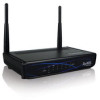ZyXEL X650 User Guide - Page 88
N Data Rate 6
 |
View all ZyXEL X650 manuals
Add to My Manuals
Save this manual to your list of manuals |
Page 88 highlights
Here are descriptions of each setup item: Fragment Threshold (1): Set the Fragment threshold of wireless radio. Do not modify default value if you do not know correct value (default value is 2346). RTS Threshold (2): Set the RTS threshold of wireless radio. Do not modify default value if you do not know correct value (default value is 2347). Beacon Interval (3): Set the beacon interval of wireless radio. Do not modify default value if you do not know correct value (default value is 100). DTIM Period (4): Set the DTIM period of wireless radio. Do not modify default value if you do not know correct value (default value is 3). Data Rate (5): Set the wireless data transfer rate to a certain value. Since most wireless devices will negotiate with each other and pick a proper data transfer rate automatically, it is not necessary to change this value unless you know what will happen after modification. N Data Rate (6): Same as above, but only for 802.11n & 802.11ac clients. Channel Width (7): Set channel width of wireless radio. You can modify default value if you know what channel width you need (default setting is '20 MHz'). Preamble Type (8): Set the type of preamble, do not modify default value if you do not know correct value (default setting is 'Short Preamble'). Broadcast ESSID (9): Decide if the wireless router will broadcast its own ESSID or not. You can hide the ESSID of your wireless router (set the option to 'Disable') so only people who know the ESSID of your wireless router can connect to it. 86















